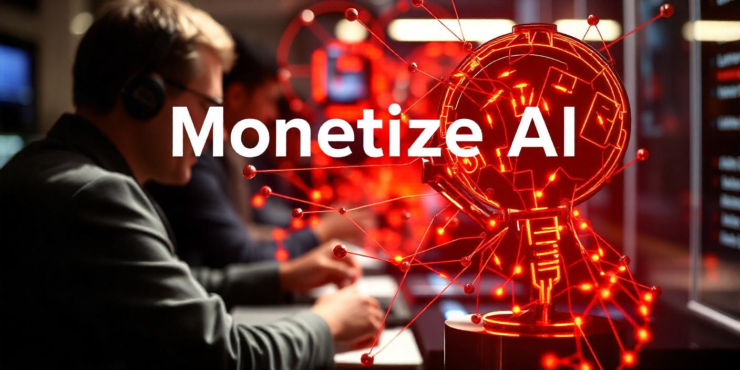Introduction:
Monetizing AI: Artificial Intelligence (AI) has transformed from a futuristic concept into a powerful tool driving innovation across industries. From healthcare to finance, retail to entertainment, AI is reshaping how businesses operate and deliver value. However, with great potential comes the question: **How can AI be monetized effectively?** Whether you’re a startup, an established enterprise, or an individual developer, understanding how to turn AI into a revenue-generating asset is crucial in today’s competitive landscape. This article explores actionable strategies, real-world examples, and key considerations for monetizing AI, helping you unlock its full financial potential.
Understanding the AI Monetization Landscape
AI monetization refers to the process of generating revenue from AI-driven products, services, or solutions. The first step in monetizing AI is understanding the diverse opportunities available. These include selling AI-powered software, offering AI-as-a-Service (AIaaS), licensing algorithms, or integrating AI into existing products to enhance their value.
For instance, companies like OpenAI monetize their AI models, such as GPT, by offering APIs to developers and businesses. Similarly, AI-driven analytics platforms help organizations make data-driven decisions, creating a lucrative revenue stream. The key is to identify a niche where AI can solve specific problems or improve efficiency, thereby creating value for customers.
Building AI-Powered Products and Services
One of the most direct ways to monetize AI is by developing AI-powered products or services. This could range from chatbots and virtual assistants to predictive analytics tools and recommendation engines. For example, Netflix uses AI to personalize content recommendations, enhancing user experience and retaining subscribers.
To succeed in this space, it’s essential to focus on solving real-world problems. Conduct market research to identify pain points and tailor your AI solutions accordingly. Additionally, ensure your product is user-friendly and scalable, as these factors significantly impact adoption rates and long-term profitability.
Offering AI-as-a-Service (AIaaS)
AIaaS is a cloud-based model that allows businesses to access AI tools and capabilities without significant upfront investment. This approach is particularly appealing to small and medium-sized enterprises (SMEs) that may lack the resources to develop AI in-house. Companies like Amazon Web Services (AWS), Google Cloud, and Microsoft Azure offer AIaaS platforms, enabling businesses to leverage machine learning, natural language processing, and computer vision.
By offering AIaaS, you can generate recurring revenue through subscription models or pay-as-you-go pricing. This model also allows for continuous updates and improvements, ensuring your offerings remain competitive.
Licensing AI Algorithms and Models
Licensing AI algorithms and models is another effective monetization strategy. If you’ve developed a unique AI solution, you can license it to other businesses for use in their operations. For example, IBM’s Watson AI is licensed to healthcare providers for diagnostic purposes, creating a steady income stream for IBM.
To maximize the potential of this strategy, ensure your algorithms are well-documented, easy to integrate, and compliant with industry standards. Additionally, consider offering customization options to meet the specific needs of different clients.
Integrating AI into Existing Business Models
For businesses already operating in traditional industries, integrating AI into existing products or services can unlock new revenue streams. For instance, e-commerce platforms use AI to optimize pricing strategies, while logistics companies leverage AI for route optimization and demand forecasting.
The key to successful integration is to start small and scale gradually. Identify areas where AI can add the most value, such as automating repetitive tasks, improving customer engagement, or enhancing decision-making processes. By doing so, you can enhance your offerings without disrupting your core operations.
Conclusion:
Monetizing AI is no longer a distant dream but a tangible reality for businesses and individuals alike. From developing AI-powered products to offering AIaaS and licensing algorithms, the opportunities are vast and varied. However, success in this space requires a deep understanding of market needs, a focus on solving real-world problems, and a commitment to continuous innovation.
As AI continues to evolve, so too will the ways in which it can be monetized. By staying ahead of the curve and embracing these strategies, you can position yourself to capitalize on the AI revolution. Whether you’re a tech enthusiast, a business owner, or an investor, now is the time to explore how AI can drive revenue and create lasting value.
Frequently Asked Questions (FAQs):
1. What is AI monetization?
AI monetization refers to the process of generating revenue from AI-driven products, services, or solutions. This can include selling AI software, offering AI-as-a-Service, licensing algorithms, or integrating AI into existing business models.
2. How can small businesses monetize AI?
Small businesses can monetize AI by leveraging AI-as-a-Service platforms, developing niche AI solutions, or integrating AI into their existing operations to improve efficiency and customer experience.
3. What are some examples of AI monetization?
Examples include Netflix’s personalized recommendations, IBM Watson’s healthcare diagnostics, and OpenAI’s API licensing for developers.
4. Is AI monetization only for tech companies?
No, AI monetization is not limited to tech companies. Businesses in various industries, such as healthcare, retail, and logistics, can integrate AI into their operations to create new revenue streams.
5. What are the challenges of monetizing AI?
Challenges include high development costs, data privacy concerns, and the need for continuous updates and improvements. However, these can be mitigated through strategic planning and partnerships.

